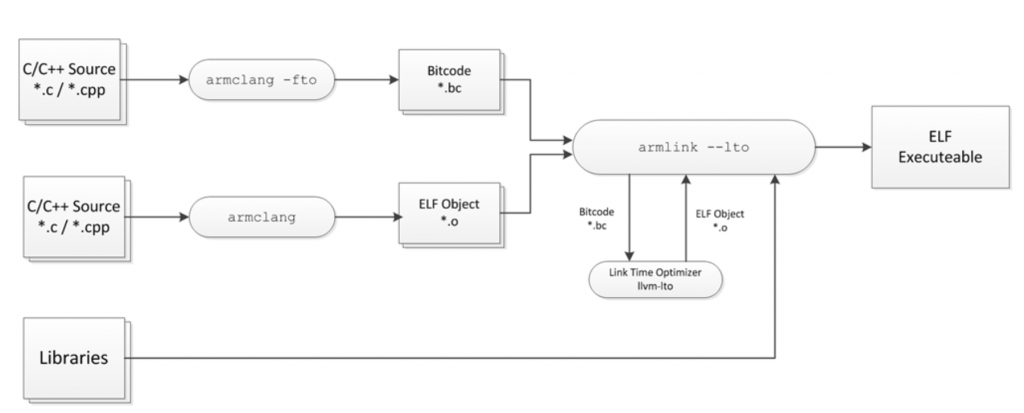Link time optimization (LTO) 的功能如同他的名字 (self-explanatory),就是在將各個 object file 鏈結起來前再做一次優化,而如果沒有使用 LTO 的話,編譯器就只會對各個檔案分別最佳化。
透過 LTO 能加強 fuzzer 的效率,舉例來說 fuzzer AFL++ 透過 LTO 做到避免執行期間產生的 edge value 出現碰撞的情況,也就是 collision-free instrumentation (文件),結果顯示提升了 10-25% 的執行效率。
文件 Link Time Optimization in ARM Compiler 6 中有對 LTO 做完整的說明,接下來的文章中也參考了此文件的資源,有興趣的讀者可以在自行閱讀。
LTO 在整個編譯流程的哪個部分,能從下圖清楚了解:

以 llvm 官方文件 提供的範例程式碼為例,能更了解 LTO 實際上做了哪些優化:
// --- a.h ---
extern int foo1(void);
extern void foo2(void);
extern void foo4(void);
// --- a.c ---
#include "a.h"
static signed int i = 0;
void foo2(void) {
i = -1;
}
static int foo3() {
foo4();
return 10;
}
int foo1(void) {
int data = 0;
if (i < 0)
data = foo3();
data = data + 42;
return data;
}
// --- main.c ---
#include <stdio.h>
#include "a.h"
void foo4(void){
printf("Hi\n");
}
int main() {
return foo1();
}
分析這三個檔案 (main.c, a.c, a.h),可以發現一些架構上的問題:
foo1()
foo4() 沒有被使用到i 預設為 0,雖然可以透過 function foo2() 賦值 -1,不過程式並沒有呼叫 foo2(),因此 i 值恆為 0foo3() 也不可能被呼叫到 (需滿足 i < 0)foo1(),並且 i 值為 0,其他的 function 與 condition 都是多餘的如果編譯時使用 LTO,就可以把這些沒有使用到的 function 移除,優化執行檔的大小。下方為編譯時使用 LTO 所需要傳入的參數:
# -flto 會輸出 bitcode 格式的 object file
clang -flto -c a.c -o a.o
# 兩者擇一,如果不加 flto 就會產生 ELF format 的 object file
clang -flto -c main.c -o main.o
clang -c main.c -o main.o
# 處理 bitcode / ELF 並做 LTO,最後產生 main 執行檔
clang -flto a.o main.o -o main
最後透過 objdump 看執行檔 main,會發現使用者撰寫的程式碼只留下 main() 與 foo1(),並且在 foo1() 對於 i 的檢查也被優化掉了:
0000000000001130 <foo1>:
1130: 55 push rbp
1131: 48 89 e5 mov rbp,rsp
1134: c7 45 fc 00 00 00 00 mov DWORD PTR [rbp-0x4],0x0
113b: 8b 45 fc mov eax,DWORD PTR [rbp-0x4]
113e: 83 c0 2a add eax,0x2a
1141: 89 45 fc mov DWORD PTR [rbp-0x4],eax
1144: 8b 45 fc mov eax,DWORD PTR [rbp-0x4]
1147: 5d pop rbp
1148: c3 ret
0000000000001150 <main>:
1150: 55 push rbp
1151: 48 89 e5 mov rbp,rsp
1154: 48 83 ec 10 sub rsp,0x10
1158: c7 45 fc 00 00 00 00 mov DWORD PTR [rbp-0x4],0x0
115f: e8 cc ff ff ff call 1130 <foo1>
1164: 48 83 c4 10 add rsp,0x10
1168: 5d pop rbp
1169: c3 ret
如果把參數 -flto 移除,代表不做 LTO,則執行檔 main 會包含許多用不到的程式碼:
0000000000001140 <foo4>:
1140: 55 push rbp
...
114d: e8 de fe ff ff call 1030 <printf@plt>
...
0000000000001160 <main>:
...
116f: e8 1c 00 00 00 call 1190 <foo1>
...
1179: c3 ret
0000000000001180 <foo2>:
1180: 55 push rbp
...
118f: c3 ret
...
Edge collision,又稱作 path collision,指的是不同的兩組 basic block 組合產生了相同的 edge value,如果參考 AFL 算 edge value 的方法,可以想成發生 bb_id(bb_a) ^ bb_id(bb_b) 等同於 bb_id(bb_c) ^ bb_id(bb_d) 的情況 (bb 為 basic block 縮寫),這樣會讓 fuzzer 認為這兩個不同的 path 是同一個,以至於漏失許多走到新 path 的情況。
Basic block ID 在編譯時期就已經決定好,因此如果要避免這種情況發生,就必須在編譯的流程中處理,因此論文 CollAFL: Path Sensitive Fuzzing 不僅發現這個情況發生的比想像中頻繁,造成效能的下降,同時也提出透過在 clang LTO pass 實作相關演算法來處理這個問題,而類似的機制後來在 AFL++ 也有實作,不過我不確定兩者之間的關聯,AFL++ 的 LTO 處理可以參考原始碼 SanitizerCoverageLTO.so.cc。
